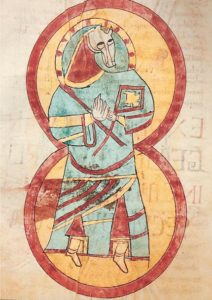Le Livre d’heures de François de Kerboutier
Texte publié dans : Jean-Luc Deuffic, Notes de bibliologie. Livres d’heures et manuscrits du Moyen Age identifiés, dans Pecia. Le livre et l’écrit, 7, 2009 [Lien].
The Decorated Letter
Exhibition : The Decorated Letter
Novembre 13, 2007 – January, 27, 2008, at the Getty Center:

(c) Getty Center. Ms 17, f. 13 v. England, ca 1420/1430.
On the pages of medieval manuscripts, vines and luxuriant leaves twist together to create letter forms. Within the letters, fantastic figures of humans, animals, and mythological beasts clamber through the tangled foliage and occasionally transform into letters themselves. Other letters contain simple author portraits or serve as a frame for scenes of important events in a story. This exhibition examines these different letter types in medieval manuscripts and explores what they reveal about changes in manuscript illumination over the course of many centuries.
Site web [Link]
Histoire des bibliothèques anciennes : les livres de juristes
Le séminaire Histoire des bibliothèques anciennes organisé par l’ Institut de Recherche et d’Histoire des Textes le vendredi 14 décembre 2007 sera une séance « orléanaise », consacrée essentiellement à des collections de livres juridiques et à leurs vicissitudes (10h – 12h30, IRHT, 40 av. d’Iéna, Paris 16e, salle Jeanne Vielliard)
Charles VULLIEZ (Université de Reims-Champagne-Ardenne)
La circulation des livres à Orléans au XVe siècle à partir des registres des notaires
Orléans a été au Moyen Âge un brillant foyer d’études, au XIIe siècle dans le domaine des « auteurs » et de la poésie, entre les XIIe et XIIIe pour l’art du dictamen, à partir du deuxième tiers du XIIIe siècle pour les disciplines juridiques, spécialement le droit romain.
Orléans n’a cependant pas eu de chance en ce qui concerne les manuscrits des œuvres étudiées dans ses écoles ou son université ou produites par celles-ci. Dans le Catalogue des manuscrits de la Bibliothèque municipale de la ville, alias maintenant Médiathèque, surtout riche du fonds de l’ancienne abbaye de Fleury (Saint-Benoît-sur-Loire), on peut compter sur les doigts de la main les spécimens médiévaux hérités desdites écoles urbaines et université. Par ailleurs, à l’exception d’un petit inventaire, daté de 1420, conservé dans le « livre » de la nation de Touraine de l’université de la ville, aucun catalogue médiéval ne subsiste pour ces institutions. Aussi, toutes les mentions de manuscrits, tous les actes qui peuvent faire état de dons, ventes, mises en gage ou autres transactions intéressant ces derniers, sont-ils les bienvenus. C’est pour cette raison que nous avons décidé de faire un sort particulier aux indications de ce type qui figurent dans les minutes notariales du XVe siècle encore conservées pour cette ville ou qui avaient fait l’objet de transcriptions manuscrites par des érudits locaux, en l’occurrence les membres de la famille Jarry, pour celles détruites en 1940.
C’est à la présentation de ce petit corpus en gestation, pour lequel nous envisageons la possibilité d’une édition scientifique ultérieure, que nous voudrions nous attacher dans cette communication : nous ferons un tour d’horizon succinct de la documentation que nous avons actuellement rassemblée dans ce sens, à partir des transcriptions recueillies ou des minutes dépouillées et en nous interrogeant sur ce que ce type de sources est susceptible de nous apprendre sur la « circulation » des livres à Orléans en ce XVe siècle.
Florence FOURNIER (master de l’Université de Tours, CESR)
Les tribulations des livres de la grande Chancellerie de France
Le centre Augustin Thierry, site orléanais de l’IRHT, conserve un important fonds ancien (XVIe-XVIIIe siècles), spécialisé dans le domaine juridique et traditionnellement appelé « fonds de la Chancellerie ». Lorsque nous avons eu la chance de recevoir l’an dernier (dans le cadre de notre Master 2) la charge de ce fonds, il nous a fallu, en parallèle à un travail de conservation et de mise en valeur, tenter d’expliquer la présence à l’Institut de ces livres dont le nom seul évoque un brillant passé. Nous livrerons ici les quelques résultats de nos recherches, qui nous ont amenée à suivre les tribulations du fonds depuis sa création (officiellement en 1759) et sa conservation à la Chancellerie de France, jusqu’à ce qu’une partie des livres, passée par les structures ministérielles qui remplacèrent après la Révolution la Chancellerie, soit remise à l’IRHT en 1976, et encore pour les trente ans qui suivirent. Ces vicissitudes des livres, associées à la rareté de nos sources (essentiellement constituées des marques présentes sur les livres) et à leur maniement délicat (pour les documents d’archive en particulier) ont conféré à notre recherche des allures, parfois, d’enquête de roman policier.
contact : anne-marie.turcan[at]irht.cnrs.fr
Site web IRHT (Institut de Recherche et d’Histoire des Textes) [Lien]
Colloque sur Jean Mabillon
Jean Mabillon, entre érudition et histoire culturelle
Colloque pour le tricentenaire
7/12/2007 au 8/12/2007
Renseignements : [En ligne]
Tél. 01 44 41 43 10 fax 01 44 41 43 11
PAGES ANNEXES
Auteur du blog : Jean-Luc DEUFFIC




